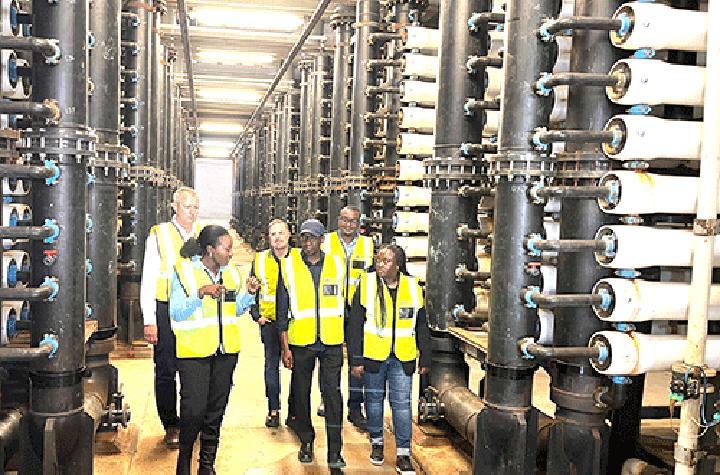Africa-Press – Namibia. The Erongo Desalination Plant, one of Namibia’s key strategic water assets, marked its 15 years in existence on Friday.
The utility, which to date has supplied more than 123 million cubic litres of water to mines and households in the region, also celebrated the fact that this was done safely — without a single lost-time injury.
Desalination is a process to remove salt and other impurities from seawater to make it safe for human consumption or industrial use. The most common method is reverse osmosis, where seawater is pushed through special membranes that separate the salt from the water. Clean water is then stored and used, while the remaining salty water, called brine, is released back into the ocean.
The Orano desalination plant was constructed in 2010, to provide water to the Trekkopje mine. However, the mine was put into care and maintenance due to continued low uranium prices following the Fukushima disaster in Japan.
The plant, situated 30 kilometres at Wlotzkasbaken settlement outside Swakopmund towards Henties Bay, has since become a key player in supplying water to Erongo, which continuously battles with water shortages. It is the largest reverse osmosis seawater desalination plant in southern Africa.
Speaking at the celebration, Erongo governor Neville Andre said the plant had proved to be a critical partner in regional development and industrial sustainability.
“The Erongo desalination plant has always operated on the basis of partnership,” Andre said. “If we did not have this plant, I cannot imagine the consequences. It is not just a regional asset — it is a national one.”
The celebration also honoured the dedicated workforce behind the plant’s seamless operation.
Suzie Nkambule, CEO of Nafasi Water, praised the team for their discipline and safety culture. “To run a facility this complex for 15 years without a single lost-time injury is extraordinary. These are not paper cuts we’re talking about —this includes high-risk environments with deadly chemicals and equipment under extreme pressure,” she said.
She also highlighted a particularly dangerous maintenance operation involving the plant’s submerged intake lines. “When a plug holding back the Atlantic slipped, our team knew exactly what to do. Their calm response in flooding conditions prevented a disaster,” she added.
The plant, initially developed to supply water to the now-mothballed Trekkopje mine, has since become vital to regional water supply and industrial needs.
Tommie Gouws, managing director of Orano said: “We are nearing 125 million cubic metres of water produced. On our peak day last month, we processed more than 63 million litres. This speaks volumes about the excellence of this team,” he said.
He further revealed that the facility will soon commission a solar project that will produce 30% of its energy needs, contributing to sustainable water production.
“This plant is a symbol of Namibian excellence and resilience,” Gouws said.
For More News And Analysis About Namibia Follow Africa-Press






